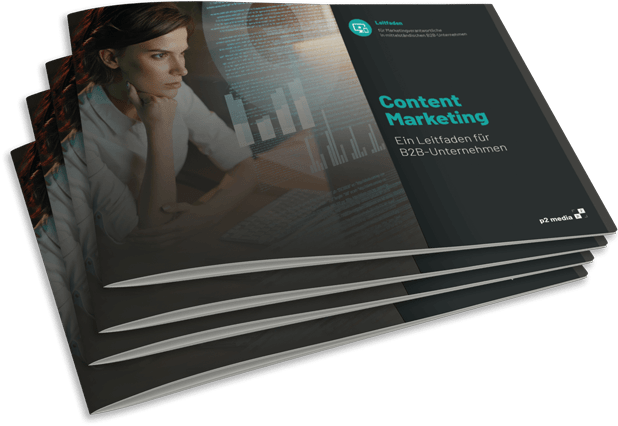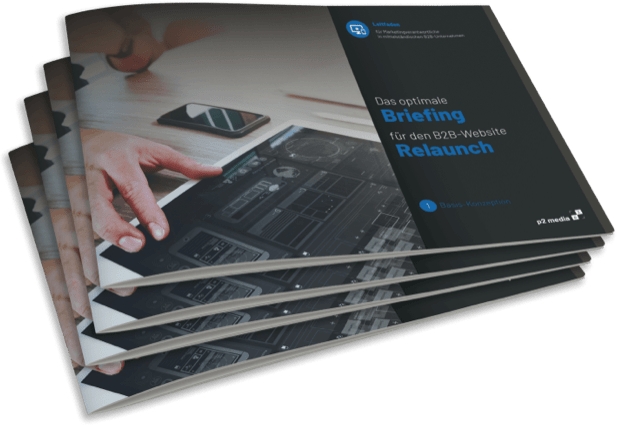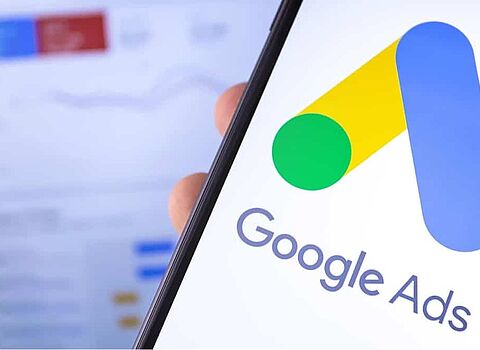As soon as they become aware of a business challenge or a corresponding need of any kind, (potential) B2B customers have long since started to search online for applicable solutions. In connection with B2B goods or services, which often have a complex scope of application and are associated with considerable acquisition costs, these are all the more aimed at obtaining the most meaningful, substantial information possible. Advertising is often frowned upon in this context. Programmatic advertising, however, can manage to bridge the gap between the promotion of company services and the all-important feeling of real added value of those in the viewers. In fact, modern Programmatic Advertising not only works in typical online channels, but is growing more and more beyond them.
Was ist Progammatic Advertising?
In simple terms, programmatic advertising is digital advertising that automatically selects its target group and platforms for playout or advertising space.
The advertisers form the demand side. The demand side uses a real-time bidding (RTB) process to bid for advertising space based on a predefined budget, which is then made available by the sell side, i.e. the providers of advertising space (on the Internet).
Artificial intelligence (AI) is a decisive factor here. In fact, it plays a decisive role in ensuring that the desired target group is actually reached accurately. Corresponding algorithms require the largest possible data so that they can unfold their full power. Accordingly, a fairly extensive database is required in order to pick up one's own target group as effectively as possible. The programmatic system uses this information, especially for RTB, which ultimately determines and auctions the optimal place to display the ads.
On the other hand, the algorithms of the sell side also use complex data sets, on the basis of which they make a prediction about the conversion rates, click-through rates and other success-relevant aspects that are likely to be achieved. A bidding algorithm then converts this predicted value into a specific bid price for a particular advertising space. All of this - including the display of the advertisement - takes place in real time. A decision or the bid price is already made while the website is loading for the user.
What are the advantages of Programmatic Advertising for companies?
Digital advertising is not dead - even if it seemed that way several times over the years. However, it has had to undergo a fundamental change. Today, even in the context of promotions, it is important to take into account the great desire for real added value of (potential) customers. The fact that Programmatic Advertising is on the rise is fundamentally due to the very simple procedure behind it on the one hand and on the other hand to its efficiency with regard to the so important added value mediation just mentioned as well as other decisive marketing factors. In fact, the automated real-time auction process of Programmatic Advertising is increasingly replacing the traditional manual purchase of specific advertising space (on the web). In this way, the receipt of a target group-specific advertising space and the playout of the advertising message that is precisely tailored to the visitor profile is regulated in real time and completely automatically. There is no need for a lengthy, complicated selection of the advertising platform, relevant negotiations and the manual purchasing process. In fact, all the tasks involved in planning and distributing advertising content are integrated into the Programmatic system.
This virtually guarantees that ads will always be served to the most appropriate target audience or in the context of their use of the carrier websites and their content. Such automated advertising is thus almost always really interesting for (potential) customers, whereby the so centrally important added value premise is mostly fulfilled.
This tends to result in a significantly higher conversion rate and an increase in revenue in relation to the expenditure on programmatic advertising. In addition, wastage is minimised, which means that advertising can be implemented more efficiently overall.
What is essential to consider for successful Programmatic Advertising in 2021?
Of course, the developments described below do not have to be implemented comprehensively in every company context - it may well be that one or the other measure is not at all beneficial for one's own purposes. Nevertheless, the current status should at least be known to anyone who operates programmatic advertising or is considering its inclusion in the respective marketing concept. Only if the potentials associated with programmatic advertising are realized, it is possible to use or consider them for one's own business activities.
Automated advertising, which is DOOH, is outdoor advertising on screens connected to programmatic systems. Programmatic advertising is thus increasingly finding its way out of classic online channels. Recipients do not need their own medium, such as a PC or smartphone, to receive this type of promotion. The playout is similar to analog advertising in public spaces on special advertising spaces. However, these are of course not advertising pillars, etc., but screens. In the B2B area, this type of programmatic advertising is suitable for trade fairs, airports, train stations and other locations where the relevant people often spend time.
DOOH advertising spaces are suitable for both brand and performance marketing. They go hand in hand with the great advantages of classic media, i.e. in particular publicity and reach. These are combined with digital advertising strengths in the form of moving images as well as targeted control of the playout according to location, time or even weather conditions and with a predefined insertion frequency. Audio promotions in entrance halls or elevators are also conceivable in this context. In the USA, such formats are already increasingly being used.
Voice search via voice assistants and voice commerce are playing an increasingly important role in marketing. Here, programmatic advertising can be precisely aligned with the terms used as voice-activated advertising, similar to written search. In addition, in such activities for the SEO, which is nowadays extremely crucial for success in practically every online marketing discipline, must be proceeded differently to the "standard" in many places.
Programmatic advertising can actually be crucial here in providing marketers with the perfect ranking for searches via voice assistants and smart devices. The latter then play out the potentially right information with a subtly packaged brand message in response to the relevant search query of the respective user.
Due to its enormous bandwidth, the 5G network is highly relevant in connection with the playout of automated advertising. This means that programmatic advertising ads can not only be placed in the right places even faster and with perfect timing - it is also possible under this condition to place significantly more elaborate formats, especially video ads, for smartphones as well. Here, the possibilities are still relatively limited.
Today, personalization is a very important topic on all levels of online sales of goods or services. Millennials in particular, as well as the smartphone generation, attach great importance to individuality and a corresponding personalization of web content or advertising. In the future, this development will continue to advance.
Even today, truly appropriate marketing and advertising measures, even in the B2B sector, always refer precisely to the respective target group and increasingly try to reach them on a personal level. No wonder, because comprehensive, strategically clever personalization creates trust and the generation of this is extremely important, especially in relation to often complex, expensive B2B products.
Counter blockers are not a trend that relates to the playout of programmatic advertising per se, but it is very closely connected with it and with ensuring that the full potential of this form of advertising is realized. For example, ads are often simply excluded by ad blockers - the figures for the use of such programs have been rising steadily for years. So-called counter blockers, however, enable ad blockers to be effectively overridden.
In simplified terms, web users receive automated advertising via the counter blocker, even though the ad block software is switched on. However, this is done in a much more discreet manner - no pop-ups or layers are displayed, for example. According to statements by the leading providers, ads lose virtually no effect here. High click-through rates and conversion rates can be recorded.
What does the GDPR mean for Programmatic Advertising?
Not only the above-mentioned trends have to be considered in the context of programmatic advertising in 2021, but also the developments in data protection regulations always have to be kept in mind. Many advertisers feared an end to the programmatic market when the GDPR came into force in 2018. So far, these predictions have not come to pass and probably won't. In fact, the GDPR ensures that programmatic advertising is becoming increasingly transparent - which can definitely be seen as a positive trend because it promotes trust. In fact, user numbers and investments in online advertising via AI have increased, especially since 2018, which shows that such advertising methods are still highly relevant. However, the European General Data Protection Regulation is not the only threat to Programmatic Advertising. The E-Privacy Regulation, which has not yet been finalized but is probably inevitable, would not only pose a veritable threat to AI-powered advertising as currently interpreted, but would even have broader negative impacts on the overall user experience on the web. Among other things, it will probably lead to the complete elimination of cookies, which have been so important for marketing up to now.
The ECJ ruling of October 2019 already stipulates that the setting of cookies absolutely requires the active and completely voluntary consent of the respective user. Online advertising based on personality profiles is therefore prohibited until specific consent has been given. For programmatic advertising, which makes use of precisely such data, this currently means a very unclear legal situation. At the moment, the exact legal situation regarding such advertising measures is unclear.
However, it is already becoming apparent that the extinction of cookies may occur sooner than initially assumed. At this point, the use of many cookies is already severely restricted on a technical level. The Firefox browser is the second major browser after Safari to completely block third-party cookies. This means that today about half of all web users will no longer be able to use third-party cookies. In general, it is assumed that in the future up to 85 percent of traffic will be free of cookies. Consequently, doomsayers even see a return to the cost-per-click model.
However, various possible alternatives to the cookie are in the starting blocks. These represent a compromise between data protection and personalization. The most promising representatives currently include:
- Semantic targeting - the placement of advertising is based on defined keywords.
- Digitrust Universal ID tokens - users control the information available about themselves and release it to advertisers if they wish.
- Fingerprinting - users are identified by analyzing unique characteristics apart from cookies, such as browser navigation, the operating system used, plug-ins, but also fonts and color depths.
So the new data protection regulations and any adjustments that may follow will most likely not mean the end of Programmatic Advertising. However, increasingly close attention must be paid to proceeding appropriately in terms of data protection in the interests of both sides, i.e. not only with a focus on one's own company requirements/goals, but also with regard to the rights of (potential) customers.
By the way, the mobile market has been showing how it can work for some time. For some time now, many contexts have been working without cookies and relying on systemic identifiers. With the networking and optimization of alternative approaches to tracking based on cookies, a trend is being pursued that can produce promising innovations and enable the release of considerable creative potential.
Put simply, the restrictions of the GDPR, which do not allow personalization without user consent, are leading to new technologies that may sooner or later be at least as profitable as today's cookie methods. After all, more and more targeting techniques are being implemented that make do with significantly reduced user-related information.
Using digital trends profitably:
- In order to increase your own competitiveness, a digital strategy is necessary - we will gladly advise you with an open mind and support you in the decision-making process.
- In this step, we would also be happy to conduct a status analysis of your previous digital activities and jointly develop a digital guide for the optimization of your digital strategy.
- Our years of extensive experience enable us to implement adigital strategy in a targeted manner, through implementation and performance measurement to daily support.
We are also happy to support you with the following topics:
Oliver Parrizas will be happy to answer any questions you may have on the subject. +49-800-911-91-91










